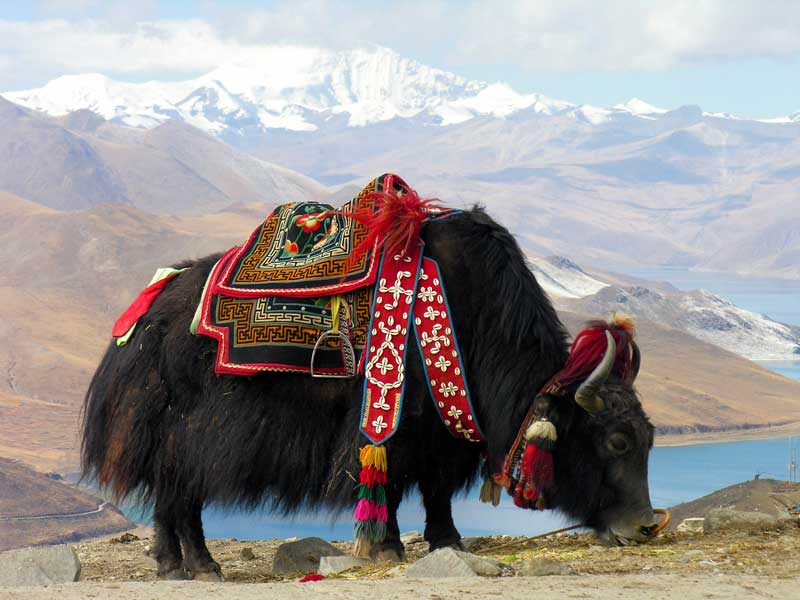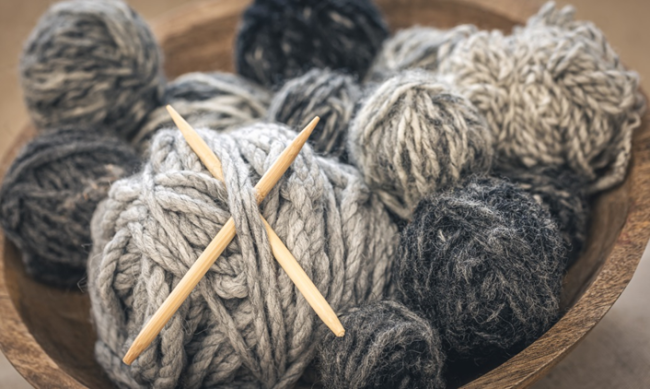
Yak wool: The fibre gift of nature
Many steps have already been taken in India and around the world to make better use of otherwise less useful coarse wool fibre of yak.
The domestic Yak (Bos grunniens), also known as the Tartary ox, grunting ox or hairy cattle belongs to the family of Bovidae. These animals are commonly raised at high altitudes of 3000-5400 m above sea level, bears long hair, bulky and firm horns with colour coat often overhangs from the belly varying from rusty brown to cream in color. These long-haired domesticated cattle are found throughout the Himalayan region of the Indian subcontinent, the Tibetan Plateau, Kashmir, Tajikistan and as far north as Mongolia and Siberia. According to the 20th livestock census, the population of yak in India is around 58 thousand and approximately 45% of this population is present in the state of Jammu and Kashmir alone. The other states as Arunachal Pradesh (42 per cent), Himachal Pradesh and Sikkim also contribute a proportion to this population (DAHD, 2022). The yak fibre is utilized by pastoral nomads people living in the hills of Arunachal Pradesh as a source of their bread by making traditional items from it as caps, tents, ropes etc. Yak rearing is a profitable business as everything from yak can be utilized in its way just like a coconut in which everything from its water to hair is usable. Yak provides fibre, meat, milk, hide, and dung fuel and also can be used as a pack animal.
Yak fibre and their properties
Yak fibre is the term commonly used to refer to yak fibre wool produced from the coat hair of yaks, a long-haired bovine mainly found in the Himalayan region, Tibetan plateau, and some areas of Mongolia and Central Asia. Yak wool is generally separated into three grades when combed using carding machine premium down fibres are usually derived from the undercoat, and only the best undercoat fibres can be considered to be truly high-grade. It is high-grade yak wool fibres that are most commonly used to make items available in the market. Undercoat fibres that aren’t considered to be high-grade are usually referred to as secondary fibres which are used in blending with jute fibre sometimes to make clothes. Lastly, low-grade coarse hair fibres are usually derived from the guard coat, and these rough, inflexible fibres are only suited for carpets, ropes, tents and similarly rigid textiles. The scales over yak fibres are less pronounced so felting their property is low in coarse fibre which results in roughness in the product made from it. Like other types of wool fibre, yak wool comes under one of the best insulating wool. The details of yak fibre characters are given in Table 1.
Table 1: Types of yak fibres
| Wool parameter | Coarse fibre | Fine fibre |
| Age of clipping | 12-18 months | 12 months |
| Average yield | 1.2- 1.5 kg | 0.5 kg |
| Diameter of fibre | 50-100 µ | 16-20 µ |
| Use | Ropes, tent, caps etc. | Blankets, soft shawls etc. |
| Location on animal body | Most visible hair on animal body | Found deep on the animal body |
Another type of yak fibre is the mid-type fibre, with a diameter between 20–50 microns, this fibre is naturally strong but not stronger than the outer layers to make ropes and tents and not as fine as the down fibre for the textile industry.
Properties of yak fibre

Regarding the warmth of yak wool, it is suggested that yak wool is warmer than Merino wool. The claims vary on how much warmer the yak wool is with values ranging between 10-40 per cent.
The softness of yak wool is contributed by the down fibre with a 16–20 microns diameter and making its softness comparable to that of cashmere. The yak wool has the potential to be sold as a luxury product due to its softness and the sustainable and eco-friendly means used for gathering the fibres.
The breathability of yak wool fibre is contributed by its ability to absorb moisture relative to its weight and then release it into the air. The yak wool can absorb more than 30 per cent moisture of its weight.
The yak wool does not have any inherent strong odour. The odor-resistance quality of yak wool is contributed to the anti-microbial properties of yak fibres that prevent bacteria from living on sweat thereby considerably reducing odour.
Traditional items made of Yak fibre
The items are generally made by pastoral nomads people living in the mountains of Arunachal Pradesh called as Brokpas and the items are Chitpajaamu, Chola, Phachung, Liu etc. The Chitpajaamu is a cap made up of outer coarse hair of yak which is made by first soaking of black outer coarse hair of yak in hot whey derived from cheese and after drying molding it with the help of round shaped hammer called thong and in the final shape of hat is given by the hand.
TheChola is a jacket made up of fine down hair fibres by first washing them and drying and then rooled into a roll using chakshet, the roll then spurn onto takur and a yarn is made and that yarn is used to for making of chola. The Zidak is another product made up of longer hairs of yak that is used to make ropes, made with two yarns say black and white are separately made on takur first and then both are twisted to make the rope. The Phachungare the small bags made up of outer coarse hair of yaks. Some more items are also made by pastoral people like Liu, it is a hand-woven fabric made up of thin yarn used to make mats, blankets, tents, etc.
Value added yak fibre products
The value added to the yak wool is done to make maximum use of the down coat and coarse hair fibre produced by the yak. Some of the value-added products are like chamar/chawar, it is made from the tail of yak and used by Sikh people as they regard it as sacred and use in worshipping at gurudwaras, comes in white and black colour and prepared by trimming of tail hair and washing thoroughly with any shampoo, combed with a comb and then firmly attaching with a silver/wooden handle with glue or any adhesive material. The Thisho is another value-added product made up of coarse yak hair, it is hand knitted carpet made when the white cotton thread is put on a wooden frame known as tanshing on which yak yarn is put to make. For making them attractive some colorful dyes are also used. The Biphakmais a doormat prepared with the same wooden frame (tanshing), only the difference is the pattern of knotting. Some value crocheted products are made with coarse yak fibre as upholstery.
Issues and way forward
Declining yak population: Yak population in India according to the 19th livestock census was 76,237 which have been decreased to 58,000 in the 20th livestock census with -24.9 per cent growth rate. This decrement has been contributed to various reasons like genetic limitation, insignificant economic returns to the farmers, improper utilization of coarse hair fibre produced by the animal and the lack of knowledge of new techniques and tools among the farmers.
Initiatives to improve the yak population and encourage the usage of yak wool: The promotion of yak jute fibre blended products made from coarse yak fibre is the first and foremost initiative taken by the government of India. From time to time Yak mela is organized by the National Research Centre on Yak (NRCY), Dirang, Arunachal Pradesh, to increase awareness. During this meal various competitions are also organized, the best milk-producing yak, best yak bull and best Dzomo (yak-cattle hybrid female) are awarded. For the first time in India sets of fabric machinery for weaving yak wool products blended with other fibre has been installed at NRCY, in collaboration with ZTMC, East Zone and NIRJAFT, Kolkata.
Conclusion
The yak wool is a unique and versatile natural fibre that offers exceptional warmth, durability and softness. Its properties make it an ideal material for producing high quality outdoor clothing and its sustainability and ethical credentials make it an increasingly popular choice for the consumers who are concerned about the environmental impact of their clothing choices. Many steps have already been taken in India and around the world to make better use of otherwise less useful coarse wool fibre of yak. Further awareness and initiatives have to be taken to popularize the yak wool among the big portion of the population around the world.
References
- Bam, J., Dabi, M., and Paul, V. (2017). Traditional yak fibre products of the brokpas. the yak wool, ICAR-National Research Centre on Yak Publication, pp. 20-25.
- Bhusal, P., Banjade, M.R., Paudel, N.S. (2019). Pastoralism in crisis: mounting challenges in herding system in high altitude region of Nepal. Journal of Forest and Livelihood, 16: 56-70.
- Das, P.J., Bam, J., Paul, V., Medhi, D., Roy, A.N. and Deb, S.M. (2017). The yak wool. ICAR-National Research Centre on Yak Publication, pp. 1-10.
- Das, P.J., Deori. S, and Paul. V. (2016). Promising technology of national research centre on yak, ICAR-National Research Centre on Yak, Publication, pp. 03-08.
- DAHD (2022). Department of Animal Husbandry and Dairying, Ministry of Agriculture, Government of India, New Delhi.
- Long, R.J., Ding, L.M., Shang, Z.H., and Guo, X.H. (2008). The yak grazing system on the Qinghai-Tibetian plateu and its status. The Rangeland Journal, 30: 241-246.
About the author:
- Manav Kansal born and brought up in Ghaziabad, U.P, is pursuing BVSc & AH at ICAR- Indian Veterinary Research Institute Bareilly, UP-243122.
- Bharat Saini is from Jhunjhunu, Rajasthan. At present he is BVSc & AH scholar at ICAR.
- S Prajwal is from Coorg, Karnataka. At present he is BVSc & AH scholar at ICAR.
- Arpit Mittal is from Jaipur, Rajasthan. At present he is BVSc & AH scholar at ICAR.
- Maya Kumari is from Sikar, Rajasthan. At present she is BVSc & AH scholar at ICAR
- Hritika Aryaa is from Shamali,U.P. At present she is BVSc & AH scholar at ICAR.
- Hirdianshu Mishra is from Ludhiana, Punjab. At present he is BVSc & AH scholar at ICAR.
- Pushkal Singh is from Badohi, U.P. At present he is BVSc & AH scholar at ICAR.




